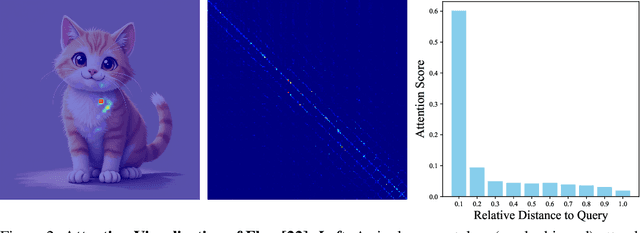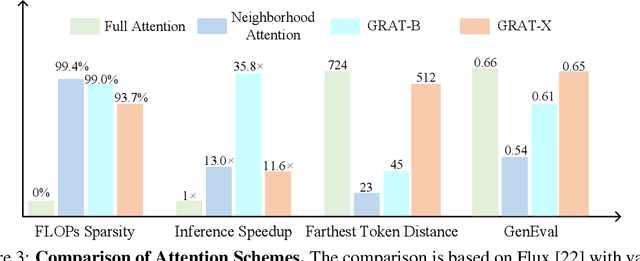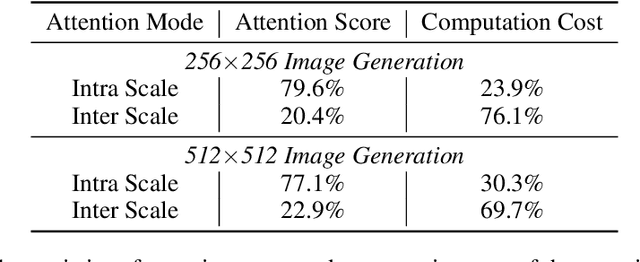Sucheng Ren
Grouping First, Attending Smartly: Training-Free Acceleration for Diffusion Transformers
May 20, 2025



Abstract:Diffusion-based Transformers have demonstrated impressive generative capabilities, but their high computational costs hinder practical deployment, for example, generating an $8192\times 8192$ image can take over an hour on an A100 GPU. In this work, we propose GRAT (\textbf{GR}ouping first, \textbf{AT}tending smartly), a training-free attention acceleration strategy for fast image and video generation without compromising output quality. The key insight is to exploit the inherent sparsity in learned attention maps (which tend to be locally focused) in pretrained Diffusion Transformers and leverage better GPU parallelism. Specifically, GRAT first partitions contiguous tokens into non-overlapping groups, aligning both with GPU execution patterns and the local attention structures learned in pretrained generative Transformers. It then accelerates attention by having all query tokens within the same group share a common set of attendable key and value tokens. These key and value tokens are further restricted to structured regions, such as surrounding blocks or criss-cross regions, significantly reducing computational overhead (e.g., attaining a \textbf{35.8$\times$} speedup over full attention when generating $8192\times 8192$ images) while preserving essential attention patterns and long-range context. We validate GRAT on pretrained Flux and HunyuanVideo for image and video generation, respectively. In both cases, GRAT achieves substantially faster inference without any fine-tuning, while maintaining the performance of full attention. We hope GRAT will inspire future research on accelerating Diffusion Transformers for scalable visual generation.
Beyond Next-Token: Next-X Prediction for Autoregressive Visual Generation
Feb 27, 2025Abstract:Autoregressive (AR) modeling, known for its next-token prediction paradigm, underpins state-of-the-art language and visual generative models. Traditionally, a ``token'' is treated as the smallest prediction unit, often a discrete symbol in language or a quantized patch in vision. However, the optimal token definition for 2D image structures remains an open question. Moreover, AR models suffer from exposure bias, where teacher forcing during training leads to error accumulation at inference. In this paper, we propose xAR, a generalized AR framework that extends the notion of a token to an entity X, which can represent an individual patch token, a cell (a $k\times k$ grouping of neighboring patches), a subsample (a non-local grouping of distant patches), a scale (coarse-to-fine resolution), or even a whole image. Additionally, we reformulate discrete token classification as \textbf{continuous entity regression}, leveraging flow-matching methods at each AR step. This approach conditions training on noisy entities instead of ground truth tokens, leading to Noisy Context Learning, which effectively alleviates exposure bias. As a result, xAR offers two key advantages: (1) it enables flexible prediction units that capture different contextual granularity and spatial structures, and (2) it mitigates exposure bias by avoiding reliance on teacher forcing. On ImageNet-256 generation benchmark, our base model, xAR-B (172M), outperforms DiT-XL/SiT-XL (675M) while achieving 20$\times$ faster inference. Meanwhile, xAR-H sets a new state-of-the-art with an FID of 1.24, running 2.2$\times$ faster than the previous best-performing model without relying on vision foundation modules (\eg, DINOv2) or advanced guidance interval sampling.
FlowAR: Scale-wise Autoregressive Image Generation Meets Flow Matching
Dec 19, 2024Abstract:Autoregressive (AR) modeling has achieved remarkable success in natural language processing by enabling models to generate text with coherence and contextual understanding through next token prediction. Recently, in image generation, VAR proposes scale-wise autoregressive modeling, which extends the next token prediction to the next scale prediction, preserving the 2D structure of images. However, VAR encounters two primary challenges: (1) its complex and rigid scale design limits generalization in next scale prediction, and (2) the generator's dependence on a discrete tokenizer with the same complex scale structure restricts modularity and flexibility in updating the tokenizer. To address these limitations, we introduce FlowAR, a general next scale prediction method featuring a streamlined scale design, where each subsequent scale is simply double the previous one. This eliminates the need for VAR's intricate multi-scale residual tokenizer and enables the use of any off-the-shelf Variational AutoEncoder (VAE). Our simplified design enhances generalization in next scale prediction and facilitates the integration of Flow Matching for high-quality image synthesis. We validate the effectiveness of FlowAR on the challenging ImageNet-256 benchmark, demonstrating superior generation performance compared to previous methods. Codes will be available at \url{https://github.com/OliverRensu/FlowAR}.
HResFormer: Hybrid Residual Transformer for Volumetric Medical Image Segmentation
Dec 16, 2024



Abstract:Vision Transformer shows great superiority in medical image segmentation due to the ability in learning long-range dependency. For medical image segmentation from 3D data, such as computed tomography (CT), existing methods can be broadly classified into 2D-based and 3D-based methods. One key limitation in 2D-based methods is that the intra-slice information is ignored, while the limitation in 3D-based methods is the high computation cost and memory consumption, resulting in a limited feature representation for inner-slice information. During the clinical examination, radiologists primarily use the axial plane and then routinely review both axial and coronal planes to form a 3D understanding of anatomy. Motivated by this fact, our key insight is to design a hybrid model which can first learn fine-grained inner-slice information and then generate a 3D understanding of anatomy by incorporating 3D information. We present a novel \textbf{H}ybrid \textbf{Res}idual trans\textbf{Former} \textbf{(HResFormer)} for 3D medical image segmentation. Building upon standard 2D and 3D Transformer backbones, HResFormer involves two novel key designs: \textbf{(1)} a \textbf{H}ybrid \textbf{L}ocal-\textbf{G}lobal fusion \textbf{M}odule \textbf{(HLGM)} to effectively and adaptively fuse inner-slice information from 2D Transformer and intra-slice information from 3D volumes for 3D Transformer with local fine-grained and global long-range representation. \textbf{(2)} a residual learning of the hybrid model, which can effectively leverage the inner-slice and intra-slice information for better 3D understanding of anatomy. Experiments show that our HResFormer outperforms prior art on widely-used medical image segmentation benchmarks. This paper sheds light on an important but neglected way to design Transformers for 3D medical image segmentation.
M-VAR: Decoupled Scale-wise Autoregressive Modeling for High-Quality Image Generation
Nov 15, 2024



Abstract:There exists recent work in computer vision, named VAR, that proposes a new autoregressive paradigm for image generation. Diverging from the vanilla next-token prediction, VAR structurally reformulates the image generation into a coarse to fine next-scale prediction. In this paper, we show that this scale-wise autoregressive framework can be effectively decoupled into \textit{intra-scale modeling}, which captures local spatial dependencies within each scale, and \textit{inter-scale modeling}, which models cross-scale relationships progressively from coarse-to-fine scales. This decoupling structure allows to rebuild VAR in a more computationally efficient manner. Specifically, for intra-scale modeling -- crucial for generating high-fidelity images -- we retain the original bidirectional self-attention design to ensure comprehensive modeling; for inter-scale modeling, which semantically connects different scales but is computationally intensive, we apply linear-complexity mechanisms like Mamba to substantially reduce computational overhead. We term this new framework M-VAR. Extensive experiments demonstrate that our method outperforms existing models in both image quality and generation speed. For example, our 1.5B model, with fewer parameters and faster inference speed, outperforms the largest VAR-d30-2B. Moreover, our largest model M-VAR-d32 impressively registers 1.78 FID on ImageNet 256$\times$256 and outperforms the prior-art autoregressive models LlamaGen/VAR by 0.4/0.19 and popular diffusion models LDM/DiT by 1.82/0.49, respectively. Code is avaiable at \url{https://github.com/OliverRensu/MVAR}.
Causal Image Modeling for Efficient Visual Understanding
Oct 10, 2024



Abstract:In this work, we present a comprehensive analysis of causal image modeling and introduce the Adventurer series models where we treat images as sequences of patch tokens and employ uni-directional language models to learn visual representations. This modeling paradigm allows us to process images in a recurrent formulation with linear complexity relative to the sequence length, which can effectively address the memory and computation explosion issues posed by high-resolution and fine-grained images. In detail, we introduce two simple designs that seamlessly integrate image inputs into the causal inference framework: a global pooling token placed at the beginning of the sequence and a flipping operation between every two layers. Extensive empirical studies demonstrate the significant efficiency and effectiveness of this causal image modeling paradigm. For example, our base-sized Adventurer model attains a competitive test accuracy of 84.0% on the standard ImageNet-1k benchmark with 216 images/s training throughput, which is 5.3 times more efficient than vision transformers to achieve the same result.
What If We Recaption Billions of Web Images with LLaMA-3?
Jun 12, 2024



Abstract:Web-crawled image-text pairs are inherently noisy. Prior studies demonstrate that semantically aligning and enriching textual descriptions of these pairs can significantly enhance model training across various vision-language tasks, particularly text-to-image generation. However, large-scale investigations in this area remain predominantly closed-source. Our paper aims to bridge this community effort, leveraging the powerful and \textit{open-sourced} LLaMA-3, a GPT-4 level LLM. Our recaptioning pipeline is simple: first, we fine-tune a LLaMA-3-8B powered LLaVA-1.5 and then employ it to recaption 1.3 billion images from the DataComp-1B dataset. Our empirical results confirm that this enhanced dataset, Recap-DataComp-1B, offers substantial benefits in training advanced vision-language models. For discriminative models like CLIP, we observe enhanced zero-shot performance in cross-modal retrieval tasks. For generative models like text-to-image Diffusion Transformers, the generated images exhibit a significant improvement in alignment with users' text instructions, especially in following complex queries. Our project page is https://www.haqtu.me/Recap-Datacomp-1B/
Autoregressive Pretraining with Mamba in Vision
Jun 11, 2024



Abstract:The vision community has started to build with the recently developed state space model, Mamba, as the new backbone for a range of tasks. This paper shows that Mamba's visual capability can be significantly enhanced through autoregressive pretraining, a direction not previously explored. Efficiency-wise, the autoregressive nature can well capitalize on the Mamba's unidirectional recurrent structure, enabling faster overall training speed compared to other training strategies like mask modeling. Performance-wise, autoregressive pretraining equips the Mamba architecture with markedly higher accuracy over its supervised-trained counterparts and, more importantly, successfully unlocks its scaling potential to large and even huge model sizes. For example, with autoregressive pretraining, a base-size Mamba attains 83.2\% ImageNet accuracy, outperforming its supervised counterpart by 2.0\%; our huge-size Mamba, the largest Vision Mamba to date, attains 85.0\% ImageNet accuracy (85.5\% when finetuned with $384\times384$ inputs), notably surpassing all other Mamba variants in vision. The code is available at \url{https://github.com/OliverRensu/ARM}.
Medical Vision Generalist: Unifying Medical Imaging Tasks in Context
Jun 08, 2024



Abstract:This study presents Medical Vision Generalist (MVG), the first foundation model capable of handling various medical imaging tasks -- such as cross-modal synthesis, image segmentation, denoising, and inpainting -- within a unified image-to-image generation framework. Specifically, MVG employs an in-context generation strategy that standardizes the handling of inputs and outputs as images. By treating these tasks as an image generation process conditioned on prompt image-label pairs and input images, this approach enables a flexible unification of various tasks, even those spanning different modalities and datasets. To capitalize on both local and global context, we design a hybrid method combining masked image modeling with autoregressive training for conditional image generation. This hybrid approach yields the most robust performance across all involved medical imaging tasks. To rigorously evaluate MVG's capabilities, we curated the first comprehensive generalist medical vision benchmark, comprising 13 datasets and spanning four imaging modalities (CT, MRI, X-ray, and micro-ultrasound). Our results consistently establish MVG's superior performance, outperforming existing vision generalists, such as Painter and LVM. Furthermore, MVG exhibits strong scalability, with its performance demonstrably improving when trained on a more diverse set of tasks, and can be effectively adapted to unseen datasets with only minimal task-specific samples. The code is available at \url{https://github.com/OliverRensu/MVG}.
ARVideo: Autoregressive Pretraining for Self-Supervised Video Representation Learning
May 24, 2024



Abstract:This paper presents a new self-supervised video representation learning framework, ARVideo, which autoregressively predicts the next video token in a tailored sequence order. Two key designs are included. First, we organize autoregressive video tokens into clusters that span both spatially and temporally, thereby enabling a richer aggregation of contextual information compared to the standard spatial-only or temporal-only clusters. Second, we adopt a randomized spatiotemporal prediction order to facilitate learning from multi-dimensional data, addressing the limitations of a handcrafted spatial-first or temporal-first sequence order. Extensive experiments establish ARVideo as an effective paradigm for self-supervised video representation learning. For example, when trained with the ViT-B backbone, ARVideo competitively attains 81.2% on Kinetics-400 and 70.9% on Something-Something V2, which are on par with the strong benchmark set by VideoMAE. Importantly, ARVideo also demonstrates higher training efficiency, i.e., it trains 14% faster and requires 58% less GPU memory compared to VideoMAE.
 Add to Chrome
Add to Chrome Add to Firefox
Add to Firefox Add to Edge
Add to Edge